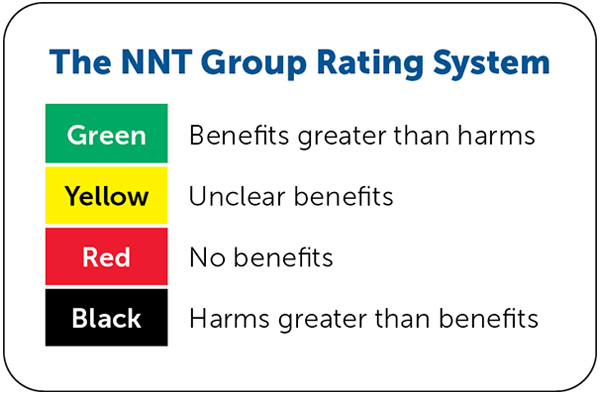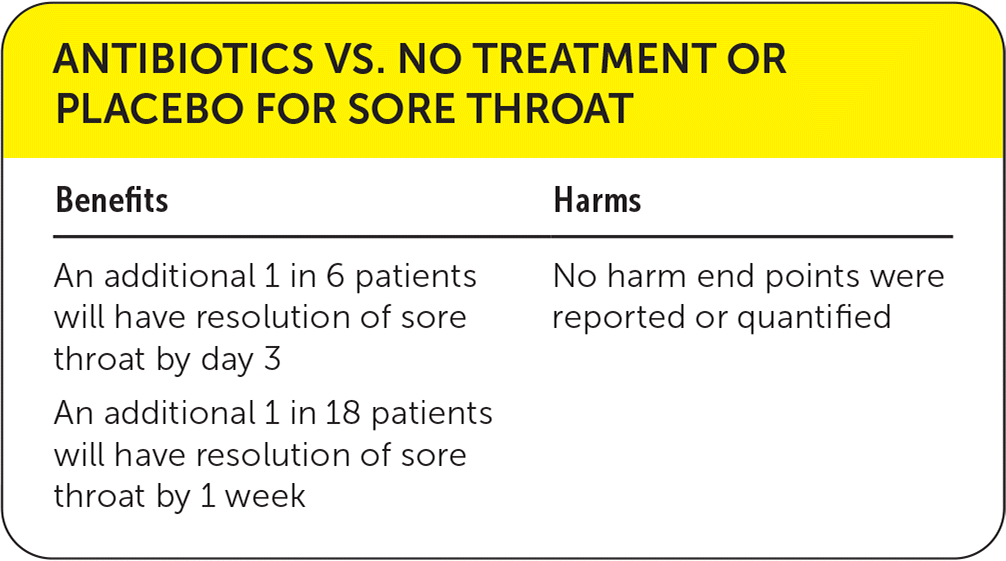
Am Fam Physician. 2022;105(6):online
Author disclosure: No relevant financial relationships.

Details for This Review
Efficacy End Points: Sore throat at day 3 and one week, fever at day 3, headache at day 3, rheumatic fever within two months, glomerulonephritis within one month, peritonsillar abscess (quinsy) within two months, acute otitis media within 14 days, and acute sinusitis within 14 days

| Benefits | Harms |
|---|---|
| An additional 1 in 6 patients will have resolution of sore throat by day 3 | No harm end points were reported or quantified |
| An additional 1 in 18 patients will have resolution of sore throat by 1 week |
Narrative: The two most common causes of sore throat are viruses and bacteria, with viruses causing up to 45% of cases.2,3 For viral infections, supportive care is the best treatment.3 Some bacterial infections of the throat warrant antibiotic therapy (e.g., group A streptococci, Neisseria gonorrhoeae, Fusobacterium necrophorum, or Corynebacterium diphtheriae infection) to reduce symptoms and prevent complications.2,3 This Cochrane review provides an updated look at the effect of antibiotics in patients presenting with a sore throat.1
A total of 29 randomized controlled trials or quasi-randomized controlled trials were selected, including 15,337 cases of sore throat overall. Children and adults were included. Studies examined different formulations, dosing regimens, and dosing routes of penicillin, chlortetracycline (not available in the United States), cefixime, sulfanilamide (not available in the United States), sulfamerazine/sulfadiazine/sulfathiazole (not available in the United States), amoxicillin, trimethoprim/sulfamethoxazole, and erythromycin.
The systematic review and meta-analysis showed that, compared with no treatment or placebo, antibiotics were effective at resolving sore throat at day 3 (relative risk [RR] = 0.70; 95% CI, 0.60 to 0.80; absolute risk reduction [ARR] = 16.7%; number needed to treat [NNT] = 6) and at one week (RR = 0.50; 95% CI, 0.34 to 0.75; ARR = 5.6%; NNT = 18). Headache symptoms were also reduced at day 3 (RR = 0.49; 95% CI, 0.34 to 0.70). Antibiotics decreased the incidence of acute otitis media within 14 days (Peto odds ratio [OR] = 0.21; 95% CI, 0.11 to 0.40) and the incidence of peritonsillar abscess (quinsy; Peto OR = 0.16; 95% CI, 0.07 to 0.35) and acute rheumatic fever (Peto OR = 0.32; 95% CI, 0.18 to 0.58) within two months. There were no significant differences in prevention of acute sinusitis within 14 days or acute glomerulonephritis within one month, the latter likely due to so few cases being reported.
Caveats: The Cochrane review had several limitations. The authors were unable to report or quantify the harms of antibiotic use in the treatment of sore throat because of poor or inconsistent reporting in the included studies. Although family physicians can provide patients with generalized guidance about possible adverse effects of antibiotics (e.g., diarrhea, rash, thrush, allergic reaction, ototoxicity), the absence of reported harms in the review limits the ability to accurately weigh the benefits of treatment against the associated risks.1,4 This is especially relevant because of the continued rise of antibiotic-resistant bacteria in our communities.2,5,6 These limitations are important for family physicians to consider as they weigh the modest symptom reduction and symptom-free status that occurred in up to 82% of participants in the placebo and no-treatment groups by one week vs. the reductions in suppurative complications (e.g., peritonsillar abscess, otitis media) and nonsuppurative complications (e.g., acute rheumatic fever) in the antibiotic group.
Many of the studies included in the Cochrane review provided no determination of sore throat etiology. Clinical practice guidelines recommend identifying common bacterial pathogens such as group A streptococci before initiating antibiotic treatment.2,7 However, two studies excluded patients with sore throats due to group A streptococci, seven studies included only these patients, and one study compared outcomes between patients who were positive and patients who were negative for group A streptococci. In a subgroup analysis evaluating sore throat resolution at day 3 of antibiotic treatment, the RR of throat pain was 0.58 (95% CI, 0.48 to 0.71) in those who were positive, compared with 0.78 (95% CI, 0.63 to 0.97) in those who were negative, suggesting that prescribing antibiotics is more beneficial for patients with sore throats caused by group A streptococci. However, the effect of group A streptococci testing on suppurative and nonsuppurative complications was not reported.
The age of the studies was another drawback of this review. Most were completed during the 1950s when rates of complications from sore throats were much higher.1 Only eight of the 29 studies were published after 1996, with four published in the 21st century, because fewer recent studies used a placebo or no-treatment arm to meet the Cochrane review's inclusion criteria. Without more recent studies, it is challenging to determine if the positive effects associated with antibiotic treatment are a result of something other than antibiotic use, such as advancements in hygiene.
Additionally, many different antibiotic regimens were studied, several of which are no longer available in the United States or elsewhere, and the use of antipyretic analgesics varied, limiting generalizability. The absence of blinding and clarity in treatment allocation procedures in some studies was also a source of potential bias.
The patients selected for participation in the trials may not entirely represent the demographic affected by sore throats and their complications. The authors recommend that more trials be completed in low-income countries and socioeconomically deprived areas of high-income countries, include children, and investigate symptom severity and duration.
We have assigned a color recommendation of yellow (unclear benefits) because of the lack of reported harms with antibiotic treatment. Until future studies further quantify harms to better weigh benefits and risks, we recommend continued use of clinical decision-making tools, rapid antigen tests, and throat cultures to ensure the accurate diagnosis of bacterial causes of sore throats and guide antibiotic prescribing consistent with current clinical practice guidelines.2,7
The views expressed in this material are those of the authors and do not reflect the official policy or position of the U.S. government, the Department of Defense, the Department of the Air Force, or the Uniformed Services University of the Health Sciences.
